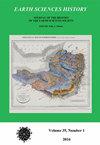阿尔伯特·C·柯的密苏里与人类与北美更新世巨型动物群的当代性争论
IF 0.3
4区 哲学
Q4 GEOSCIENCES, MULTIDISCIPLINARY
引用次数: 0
摘要
阿尔伯特·科赫是十九世纪初出现在美国舞台上的迷人人物之一。他是一位化石收藏家,受到科学家和外行的赞扬和嘲笑。在宾夕法尼亚州和密歇根州收集自然历史标本后,他在圣路易斯开设了一家博物馆,博物馆融合了自然历史物品、古玩和戏剧表演。他最为人所知的是他著名的密苏里州,这是一具严重组装错误的美国乳齿象骨架,最终被收藏在大英博物馆。由于他兜售的噱头,许多科学家认为他夸张和组装错误的骨架是一场骗局。阿尔伯特·科赫(Albert Koch)发现了已灭绝的巨型动物群和早期人类是同时代的证据,这一争论在几十年内一直悬而未决,这引发了更多的争议。这篇文章批判性地考察了科赫的化石收集追求,他对人类巨型动物协会的主张,以及他对科学和自然史的贡献。这是一篇由两部分组成的论文中的第一篇,第二篇聚焦于科赫发现和展览的一头早期古鲸,他称之为Hydrarchos,这是一具夸张的骨架,比他的密苏里州引起了更多的争议。本文章由计算机程序翻译,如有差异,请以英文原文为准。
ALBERT C. KOCH’S MISSOURIUM AND THE DEBATE OVER THE CONTEMPORANEITY OF HUMANS AND THE PLEISTOCENE MEGAFAUNA OF NORTH AMERICA
Albert Koch was one of those fascinating characters who burst upon the American scene in the early nineteenth century. He was a fossil collector who has been lauded and ridiculed by both scientists and laymen alike. After collecting natural history specimens in Pennsylvania and Michigan, he opened a museum in St. Louis, an amalgam of natural history objects, curiosities, and theatrical performances. He is best known for his famous Missourium, a grossly misassembled American mastodon skeleton that ended up in the British Museum. Because of the hokum he peddled, many scientists considered his exaggerated and misassembled skeleton a hoax. Albert Koch created additional controversy when he observed that he had uncovered evidence that the extinct megafauna and early man were contemporaneous, a debate that remained unsettled for several decades. This essay critically examines Koch’s fossil collecting pursuits, his claims of human-megafauna associations, as well as his contributions to science and natural history.
This is the first of a two-part paper, the second focusing on Koch’s discovery and exhibition of an early archaeocete whale that he called Hydrarchos, an exaggerated skeleton that created significantly more controversy than his Missourium.
求助全文
通过发布文献求助,成功后即可免费获取论文全文。
去求助
来源期刊

Earth Sciences History
GEOSCIENCES, MULTIDISCIPLINARY-HISTORY & PHILOSOPHY OF SCIENCE
CiteScore
1.00
自引率
0.00%
发文量
1
审稿时长
>12 weeks
期刊介绍:
Earth Sciences History promotes and publishes historical work on all areas of the earth sciences – including geology, geography, geophysics, oceanography, paleontology, meteorology, and climatology.
The journal honors and encourages a variety of approaches to historical study: biography, history of ideas, social history, and histories of institutions, organizations, and techniques.
Articles are peer reviewed.
 求助内容:
求助内容: 应助结果提醒方式:
应助结果提醒方式:


